Relatively new, but already popular with summer residents, is the Almaz eggplant variety.
In the East, eggplant is called a vegetable of longevity. It is valued for its low calorie content, high content of vitamins and essential minerals. In addition, their eggplant dishes are extremely tasty, healthy and suitable for dietary nutrition.
Let us next consider one of the popular eggplants varieties Diamond and learn the secrets of a rich harvest.
Description of the eggplant variety
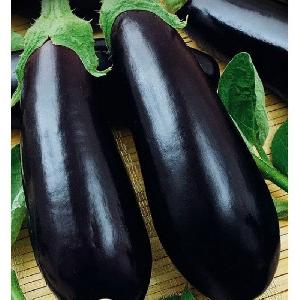 The Almaz variety was developed by Russian agronomists in 1983. Eggplant is grown in the North Caucasus, Ural, Far Eastern, and Central regions.
The Almaz variety was developed by Russian agronomists in 1983. Eggplant is grown in the North Caucasus, Ural, Far Eastern, and Central regions.
Distinctive features
In the south of the country, Almaz eggplant is grown in open ground. The vegetable is mid-season, the first harvest is harvested 120-140 days after planting. In the northern regions, gardeners grow it in a greenhouse or greenhouses. The variety is resistant to drought and heat, and rarely gets sick.
Characteristics
Neat bushes reach 0.5 m. The leaves are medium-sized and green. The fruits are cylindrical, about 15 cm long, and the diameter varies from 3 to 5 cm.
The surface is smooth, black-violet in color. Eggplant weight – 100-150 g. The flesh is dense, greenish in color. The taste is pleasant, not bitter. From 1 sq. m summer residents collect about 5-7 kg of tasty and ripe eggplants.
Interesting! In some countries, eggplants are consumed raw, since after heat treatment the vegetable loses some of its beneficial properties.
How to grow a variety yourself
The process of growing Almaz eggplant is not much different from growing other vegetable crops.Let's take a closer look at what is needed for planting and how to properly care for the plant.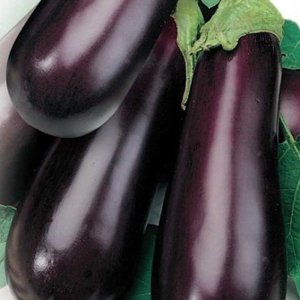
Growing seedlings
Thanks to this method, seedlings quickly adapt to external conditions and show better productivity. To do this, prepare the soil, container, and seed material:
- Ready-made soil from the store or soil from the garden are used as soil. It is necessary that it does not contain the remains of old plants, larvae, or debris. For disinfection, the soil is placed in an oven for 40 minutes at a temperature of 150 degrees. The procedure destroys dangerous microbes on the surface of the seeds.
- The best container for planting seeds is peat pots. They are easy to use and affordable. The pots are made from environmentally friendly degradable material.
- The seeds are disinfected with aloe juice. After this, they are dried, wrapped in a damp cloth and placed in a dry and warm place.
The prepared seeds are placed in containers. Place 2-3 seeds in one pot. Sprinkle the top with earth and water generously with warm water. Eggplants love warmth and light, so the seedlings are placed on the windowsill. The optimal temperature for growing is 25-30 degrees. When the first two true leaves appear, the first fertilizing is applied, for example, a solution of superphosphate with potassium salt and urea. Re-feed after 10-15 days.
Important! When growing seedlings on a windowsill, avoid drafts. Water the seedlings every 7 days. For hydration, use only settled warm water, since cold tap water increases the risk of developing diseases. Experienced summer residents organize additional illumination with phytolamps.
Transfer
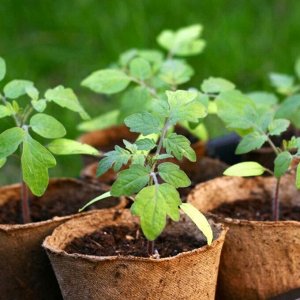
Gardeners prepare beds for eggplants in advance.The vegetable prefers a mixture of loamy and sandy loam soils. The beds must be clean, with fertile and loose soil. In autumn, fresh manure, river sand and sawdust are added to the soil. A bed 30 cm long and 1 m wide is suitable for eggplants. The soil is leveled with a rake and watered with Effekton.
When the seedlings have formed a strong root system and 5-7 leaves appear on the stems, the bushes are transplanted into the garden. It is better to carry out the procedure early in the morning on a windless and warm day. Before planting, a large amount of water is poured into the prepared holes, after which eggplant bushes are placed in the resulting “puddles”. The soil is compacted from above and sprinkled with dry sand or loose soil. The optimal distance between seedlings is 40-45 cm.
Important! Eggplant Diamond is a heat-loving plant, so at first it is covered with cling film or thin glass to protect it from possible frost and wind. Remove the film by mid-June, when the risk of frost is low.
Further care
Caring for eggplant does not require special skills. First of all, the beds are watered as they dry out. If the summer is hot, the soil is moistened every 5 days; if it’s cool – once every 7-10 days. 1-1.5 liters of water are poured onto one bush. It is better to moisten the beds in the morning or evening to avoid sunburn. Water the bushes directly at the root, bypassing the leaves and stems.
During the summer, the soil is loosened, especially after rains. Loosening makes the soil more nutritious and saturates it with oxygen.. At the same time, the beds are cleared of weeds and debris. This prevents the development of infections. Eggplants are hilled three times a season to strengthen the root system and stimulate stem development.Additionally, hilling retains moisture.
2 weeks after planting, the eggplants are fed for the first time. The vegetable loves nitrogen, potassium, phosphorus and magnesium. Summer residents fertilize the beds with potassium chloride, ammonium sulfate, superphosphate, wood ash, and humus. Fertilizers are pre-dissolved in warm water (22-24 degrees). During flowering and fruiting, plants are fertilized with nettle infusion, mullein, urea and potassium salt. Foliar feeding is practically not used.
Features of cultivation and possible difficulties
Farmers recommend paying attention to weather conditions. In cold and cool summers, eggplants require 20-30% more potassium. Dry wood ash is poured under the bushes at the rate of 2 cups per 1 square meter. m. The Riga mixture, which contains nitrogen, magnesium, phosphorus and calcium, is also useful. One tablet of the mixture is diluted in 10 liters of water.
The best predecessors of eggplant are onions or cabbage. It is not recommended to plant vegetables after tomatoes or potatoes. After the formation of the first fruits, all side shoots are removed. The formation of a bush is necessary so that ripened vegetables grow as large and tasty as possible.
Diseases and pests
The Almaz variety has high immunity to diseases, but is occasionally exposed to their negative effects.
The most common diseases are:
- Blackleg. It appears as a dark coating on the roots, due to which they begin to rot, then quickly dry out and die. For preventive purposes, it is recommended to treat seeds with manganese and disinfect the soil. Professional preparations “Fitosporin” or “Oxychom” are used for treatment.
- Mosaic is a viral disease that appears as a yellow-green pattern on the leaves.When the first signs are detected, the bushes are removed from the garden bed and burned. For protective purposes, spraying with Bordeaux mixture is used.
- Late blight – the most common disease among eggplants, potatoes, and tomatoes. It appears in the form of brown spots on the leaves, due to which the bushes begin to wither. The fungus actively develops in hot and humid summer conditions. Spraying with a whey solution helps in the fight against fungus.
- Bacterial spot appears as spots on the leaves with a dark border. For prevention purposes, it is advised to follow the rules of crop rotation and water the beds on time. In case of infection, summer residents burn the affected bushes.
Among the insect pests, aphids attack eggplant beds. The insect sucks vital juice from the leaves, as a result of which the plant dries out and dies. Favorable factors for the appearance of aphids: high humidity, heat, non-compliance with the watering regime.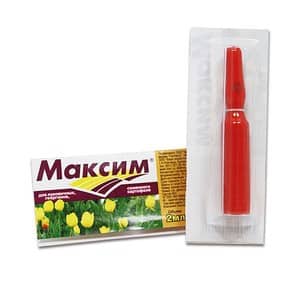
For preventive and therapeutic purposes, bushes are sprayed with a soap solution. In addition to aphids, whiteflies and spider mites negatively affect the harvest. Maxim and Strela products help in pest control.
Harvesting and application
Almaz eggplants are harvested a month after flowering. Ripe vegetables acquire a beautiful glossy color, become firm and elastic. If you do not pick eggplants on time, they become bitter, and the taste and elasticity are lost. Cut the vegetables with garden shears, leaving the stem. Vegetables with damage and scratches are eaten immediately, while smooth and whole fruits are set aside for longer storage.
Important! Eggplants can be stored for no more than one month.Tender vegetables are sensitive to light and temperatures, so they are eaten as soon as possible. The harvested crop is placed in a dark and dry place with an air temperature of 10 degrees and air humidity of 80%. Storing eggplants in the light is unacceptable, as they produce solanine. The substance makes eggplants bitter and unsafe for health.
Eggplants are actively used in cooking. They serve as the basis for such tasty and healthy dishes as eggplant caviar, vegetable snacks, and puree soups. A great way to get the most out of a vegetable and enjoy it for as long as possible is to prepare winter preparations and pickles. Housewives canned eggplants with carrots, cucumbers, tomatoes, and prepared savory snacks with horseradish, garlic and dill. When cooked, the fruits shrink significantly in size, losing liquid.
Interesting! Nutritionists recommend eating eggplants for people with cardiovascular diseases. Vegetables remove cholesterol from the body, and cardiac activity is normalized. Also, eating eggplants has a beneficial effect on the functioning of the liver and kidneys.
Advantages and disadvantages of the variety
Eggplant Diamond is named after its outstanding and numerous benefits. The vegetable looks appetizing, does not require much time and effort to care for, and fruiting is friendly and abundant. The variety rarely gets sick and shows stable yield. The pulp is not bitter and is universal in use.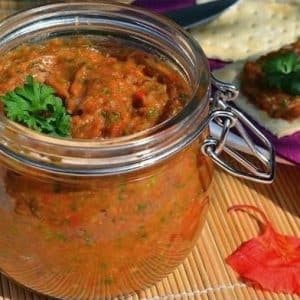
One of the disadvantages is the fact that the vegetable cannot be kept in the garden. Eggplants need to be harvested on time and eaten as soon as possible.
Reviews
Most gardeners are happy with Diamond. The variety is valued for its taste and unpretentiousness. However, some summer residents also express dissatisfied reviews.
Pavel, Orel: “I planted the Almaz variety in a greenhouse. I expected to receive a rich and tasty harvest. He followed all the rules of agricultural technology, fertilized and watered the beds on time. However, the fruits set slowly and turned out small and insipid. I absolutely didn’t like the Almaz variety.”
Arina, Moscow: «Of all the eggplant varieties, Almaz is my favorite. I like its attractive appearance and pleasant-tasting flesh. Unlike many other varieties, Almaz is not bitter and is ideal for preparing canned dishes.”
Olga, Voronezh: “I’ve been planting Almaz for the tenth season. I am very pleased with the harvest. Vegetables grow smooth and even. I use some of it myself, and from the rest I make caviar.”
Read also:
What is an eggplant - is it a berry or a vegetable?
Do you need to peel eggplants and how to do it correctly.
How dangerous are spider mites on eggplants and how to effectively fight them.
Conclusion
Eggplant Diamond is planted on light and windless plots of land. To obtain a rich harvest, seedlings are prepared. To prevent the plant from getting sick, the seeds are disinfected with manganese or aloe juice. In the future, caring for the bushes is simple and straightforward: the eggplants are watered, fertilized, and the beds are loosened.
The vegetable is not suitable for long-term storage, so experienced gardeners recommend consuming it immediately or using it for preparations. Due to the high content of vitamins and minerals, eggplants are ideal for dietary and healthy eating.